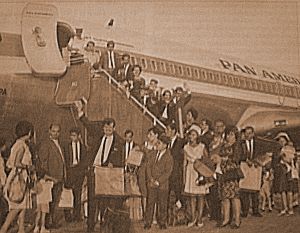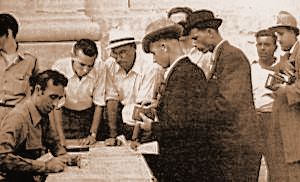Prospects in the U.S.A.
Leaving for the United States, September 1966 Malta's Council of Government issued a statement on April 8, 1947, which showed that at that time more than 5,000 people had applied to enter the U.S.A. The statement also indicated that two main obstacles were hindering the entry of these people, many of whom had relatives living in the U.S.A. for a number of years who had promised jobs and accommodation for those who wished to emigrate. The two obstacles were the fact that there was no direct shipping between Malta and the U.S.A. and the closure of the local American Consulate which in past years had been issuing visas to intending migrants. 
Bound for North America on the Marine Shark Efforts were made to eliminate such problems. The ship Marine Shark entered Maltese waters on July 7, 1947, and she took 240 migrants bound for North America. This was the first significant group to leave directly for North America. The ship took just eleven days to arrive and many of the Maltese continued their journey to Detroit and San Francisco. Most adults paid fares which ranged from £40 to £50. It was also at this time that an American consular officer paid two visits to Malta raising hopes that the local consulate will reopen soon. (5) In 1948 Mr J Cole, Malta's minister responsible for emigration, and Mr J Axisa, who was then the director of emigration, were on a visit of the main receiving countries favoured by the Maltese who wished to emigrate. While in the U.S.A. the two men were told that the process of granting visas would be speeded up. Both Mr Cole and Mr Axisa insisted with the Department of State that the presence in Malta of a permanent consul was not only greatly desired by the Maltese but also very useful because those who needed a visa had to go either to Romeor to Tunis. The two gentlemen from Malta got the impression that their request received a favourable hearing. (6) In September 1949 the American ambassador to the United Kingdom requested the approval of the British Government for the reestablishment of an American consulate in Valletta. The American Consulate was opened in February 1950 with Mr John Fitzgerald as consul aided by Mr Richard B. Andrews. At the time the two gentlemen were issuing 200 visas a month. Between 1949 and 1950 the total of approved migrants wishing to leave for the U.S.A. had reached the number of 1,324. Most left on board the two ships Italia and Neptune. While in Detroit both Mr Cole and Mr Axisa urged the local Maltese already established in the city and in other parts of Michigan to sign affidavits of support for those Maltese waiting in Malta to depart for the U.S.A. In New York the two visitors made the same appeal. In that city they were entertained by Mr Justin Piscopo, a very successful businessman who was also the owner of a chain of sixteen hotels. Mr Cole and Mr Axisa thanked their host not only for his kindness but also for his generosity towards his fellow Maltese immigrants when he helped them to find accommodation and work. (7) Another very popular Maltese living in New York was Mr Joseph E. Doublet who had been living in that metropolis since 1920. He had spent his working life with the Pennsylvania Railroad and his interest in ethnic workers was so genuine that his employers had made him responsible for the welfare of the non-English speaking workforce. In his position Mr Doublet was able to find work for many Maltese and he also obtained accommodation for them. It was to house immigrants from Malta that he had bought a fifteen-room house in Jersey City. Up to 1950 Mr Doublet had helped about 2,000 immigrants who had arrived in New York from Malta. He also was co-founder of the Malta Society of New York and The Maltese Benevolent Society. Mr Doublet was the editor of The Maltese Journal from 1930 t0 1946. This was a review widely read in North and in Malta. It was through this publication that the editor was able to launch The Malta Relief Fund to help the Maltese during the long suffering years of the Second World War. Mr Doublet died in Huntingdon, New York, in 1987. (8) Both Mr Cole and Mr Axisa urged the Maltese settlers in New York to emulate the patriotic example of Mr Piscopo and Mr Doublet. Mr Cole contacted the Grand Council of Maltese Associations of North America in order to coordinate the efforts done by those already established in the U.S.A. in favour of those prospective migrants still held in Malta because they had no one to sponsor them. Mr Cole addressed some 250 members of the Maltese Union Club at Eight Avenue, New York, and urged, them to work through the Grand Council in order to open a reception centre for Maltese disembarking at new York but had to undertake long journeys to other States. (9) The distinguished visitors from Malta learned that abuses had crept in. Reports reached them of Maltese landlords who charged exorbitant rents for a very primitive type of accommodation. Others made offers of help and asked money for services which they never rendered. Even in Malta prospective emigrants were being pestered at their homes by strangers who knocked at their doors in order to obtain bookings from them making vain promises that they were able to expedite emigration procedure. People wondered how such characters were able to obtain the addresses of those who had applied to go to the U.S.A.(10) In 1952 a total of 1,293 approved emigrants left for the U.S.A. This was the highest number of emigrants going to any country. From 1946 to 1952 the total of known emigrants to the U.S.A. was 4,520. No doubt that that country would have remained the most popular with the Maltese had it not been for an unforeseen setback which was to push the U.S.A. into the fourth place as Malta's receiving country, way behind Australia, Great Britain and Canada. The setback was the introduction of the MacCarran - Walter Act in June 1952. From 1953, when the restrictions of the Act came into force, the entry of Maltese into the U.S.A. was reduced to a mere trickle and this situation was to last until Maltese emigration to that country became irrelevant. At the time when the unwelcome restrictions were made public, the American Consulate in Malta was issuing about one hundred visas a month. A press release from the same consulate expressed the somewhat pious hope that in spite of the Act more emigrants would be able to leave for the U.S.A.(11) It was not to be. In 1953 the numbers of Maltese leaving for the U.S.A. dropped to six hundred eighty three. After that year the average intake never surpassed the three hundred. Source: The Safety Valve (1997), author Fr Lawrence E. Attard, Publishers Enterprises Group (PEG) Ltd, ISBN 99909-0-081-7
    
| 

![]() .
.